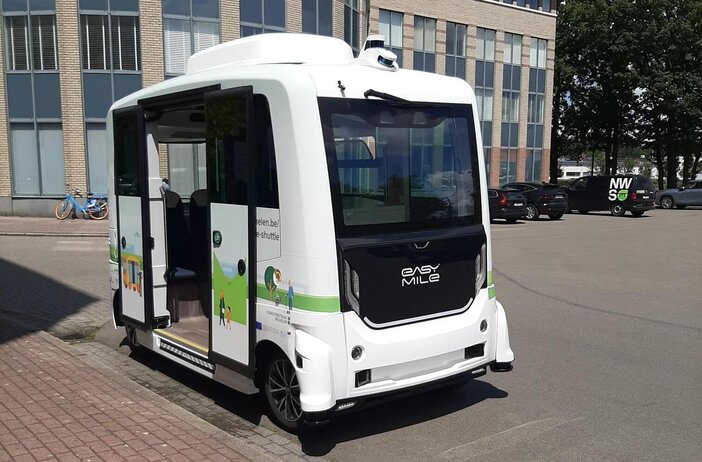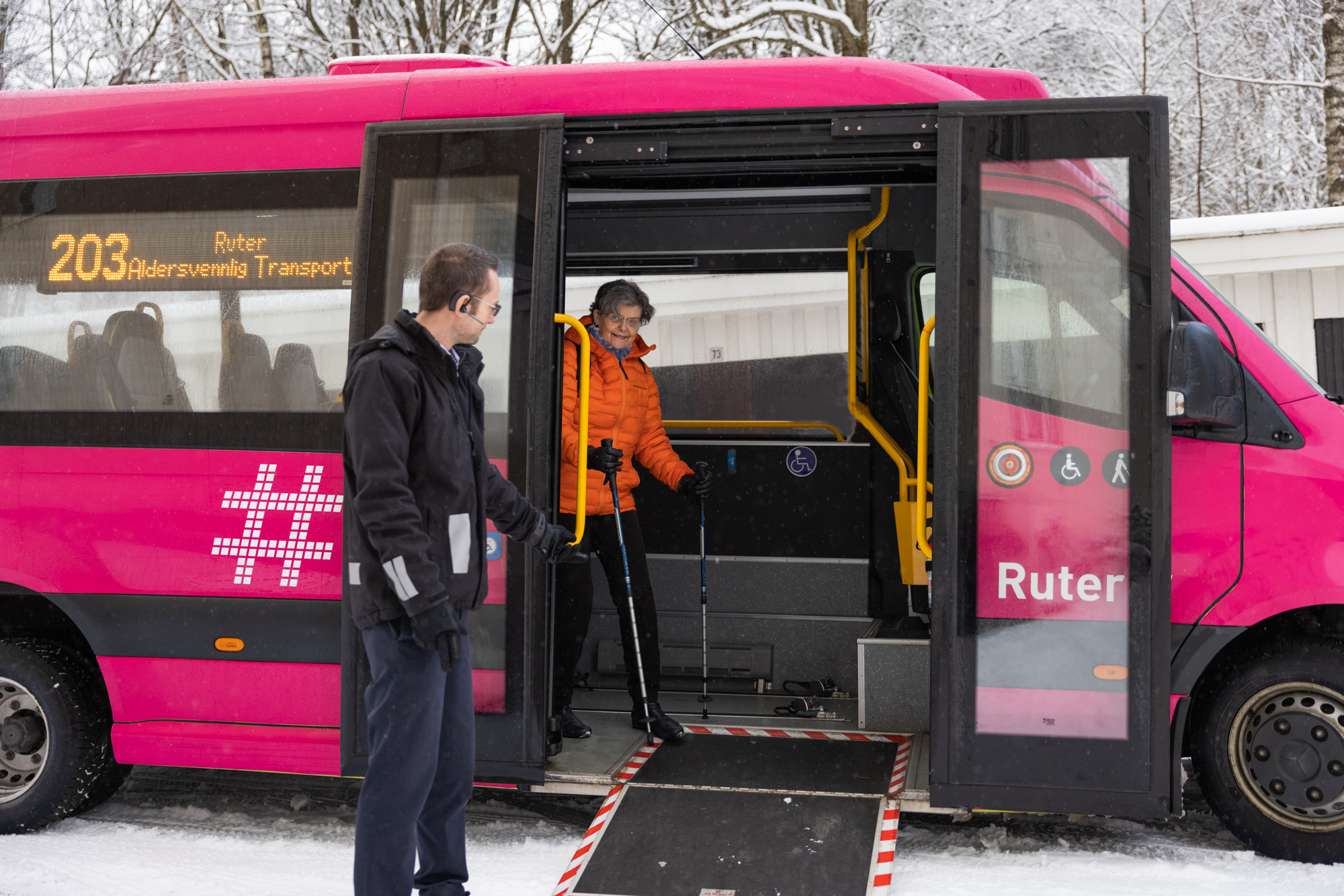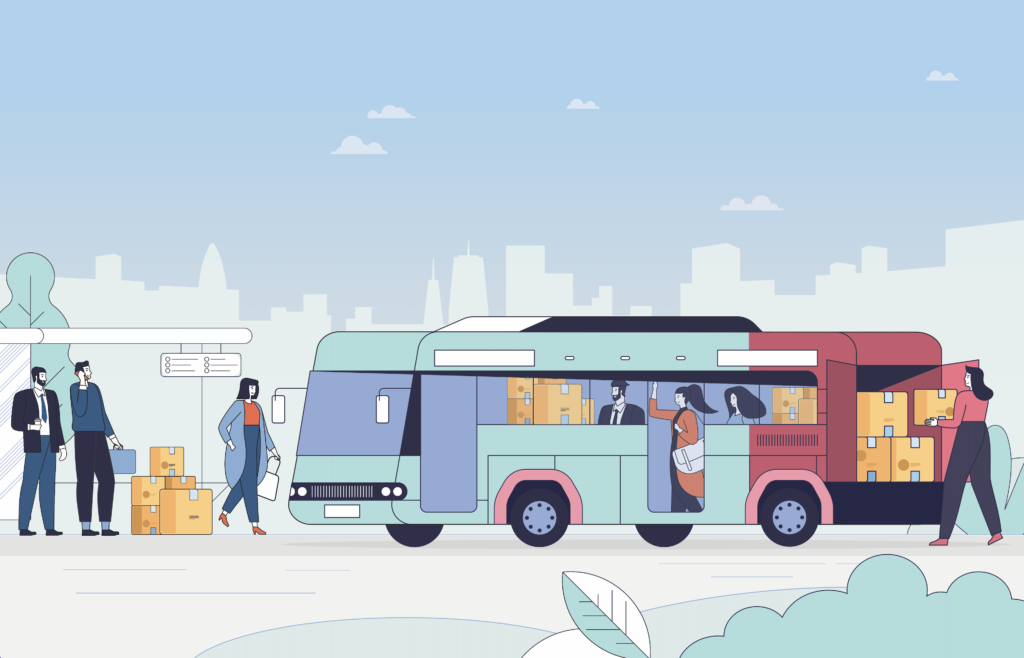Support for cargo hitching is growing following a 10-year hiatus when operational challenges hindered rollout. Helen Norman explores whether having people and freight sharing the same vehicle could be the answer to more efficient last-mile delivery
The concept of cargo hitching first came about more than 10 years ago. The idea was to combine passenger and freight flows into one vehicle to reduce empty capacity and make transportation, including last-mile delivery, more efficient and sustainable. Starting in 2012, a team from TKI Dinalog – the Dutch Institute for Advanced Logistics – ran a four-year research and pilot project to look at how cargo hitching could work in practice.
The cargo hitching project, which explored how empty capacity in buses, trains and taxis could be used to transport freight alongside passengers, uncovered several opportunities for making last-mile delivery less fragmented and more sustainable. However, it also uncovered operational challenges, which so far have halted the development of cargo hitching.
Tom Van Woensel, professor of freight transport and logistics at Eindhoven University of Technology, worked on the TKI Dinalog project. “Following the project, everything went a bit silent,” he comments. “There were a few small-scale cargo hitching-style projects here and there but no major applications. I believe the main reason why it hasn’t taken off yet is because the freight sector and public transportation are still two very separate worlds, and merging the two is extremely challenging, especially considering how fragmented the freight/delivery industry is. It’s not a one-to-one discussion but a one-to-many discussion that is needed, which isn’t easy.”
According to Van Woensel, the TKI Dinalog trial uncovered several issues that must be overcome before cargo hitching can be rolled out successfully. “Who manages the different flows – the people and freight?” he says. “Should it be the public transportation provider or the freight company? Should they be managed individually or as a system? Who invests in the extra infrastructure needed to handle the parcels, such as locker boxes? There are so many things that need to be considered.”
The TKI Dinalog project looked at how people- and freight-based transportation could be combined to take a more holistic approach to transportation in general. The institute worked with several freight firms and public transportation companies, such as bus lines, to test the concept. Cargo hitching was trialled in urban and rural environments, with parcel locker walls installed at bus stops to store parcels before the recipients could collect them.
“One of our key observations was that the potential for cargo hitching was greater in rural areas than in urban ones,” explains Van Woensel. “A lot of the buses are on set timetables regardless of how many people are using the vehicles, therefore during quiet periods there is a lot of spare capacity that could be used for freight.”
In his role at Eindhoven University of Technology, Van Woensel has continued research into cargo hitching with a focus on how trains could play a role and whether taxis could be used for the last mile. “But we are not working on any real-life applications at this time,” he adds.
Urban logistics on demand
Now, 10 years since the launch of the TKI Dinalog project, several other cargo hitching projects are emerging, some with EU funding and support. Urban Logistics as an on-Demand Service (ULaaDS) is one of those EU-funded projects. The initiative, which has a budget of €3.15m (US$3.09m) and 24 project partners, came out of Horizon 2020 – the EU’s research and innovation funding program.
“Its goal is to develop and test sustainable business models for parcel delivery, built on two main principles: collaboration and sharing logistics services and assets, and combining passenger and freight transportation, both in the urban area. The developed solutions are being tested in Bremen in Germany, Groningen in the Netherlands and Mechelen in Belgium,” explains Domien Stubbe, project leader, international at the VIL Flanders Innovation Cluster for Logistics – one of the 24 project partners.
In June 2022, VIL led a cargo hitching project as part of ULaaDS and alongside project partners SwipBox, EasyMile, Ush, bpost, the city of Mechelen and the Mechelen Noord business park.

“On June 13, 2022, an autonomous vehicle from EasyMile was introduced to the Mechelen Noord business park,” explains Stubbe. “The vehicle could transport up to eight people and featured a built-in SwipBox parcel locker. People could demand a ride through a web app built for the project, and request a delivery and/or pickup, delivered by bpost. When the vehicle arrived, customers could use the bpost app to gain a personal pickup code that would open a locker door via Bluetooth.”
The vehicle covered a 15-minute, 2.5km route on weekdays between 11:00am and 6:00pm, from June 13
to August 12, 2022, on the business park. Employees of the companies along the route could board the vehicle free of charge at various stops and use it to get to their workspaces. Meanwhile, companies and private individuals could drop off or pick up postal parcels
from bpost in the shuttle.
The parcel locker was fully integrated into bpost’s network, with the post arranging the drop-off and emptying of the locker. Bpost’s system gave an overview of which compartments were filled and which were empty. The locker featured small and medium-size compartments, although, Stubbe continues, “With hindsight, larger lockers would be better so they can
fit more parcels in.”
Project findings
Since the conclusion of the Mechelen trial, the project team has evaluated the key findings and uncovered some surprising and useful insights. “We assumed one of our biggest challenges would be filling and emptying the parcel locker, but this turned out to be simple and undertaken by postal workers in a matter of seconds,” explains Stubbe. “We did, however, find that customers preferred fixed parcel lockers, which gave them flexibility on when they could collect their parcels, rather than moving lockers that they had to wait for.
“We also had two apps – one we built for demanding a ride and one from bpost to open the locker,” he continues. “This meant there were two apps for picking up one parcel, which is just not user-friendly. We also saw low pickup rates – packages could stay in the locker for up to four days. The main reason for this was homeworking. As the trial was done on a business park, workers were only at the office for one or two days a week. This resulted in a full fill rate of the locker but a low pickup density. This is not a good indicator if you want to make it profitable.”
The project team is still evaluating the trial, but overall it believes that cargo hitching does not work best at business parks. “We believe that this type of solution would work better in a rural area, where the need for public transportation is high and parcel delivery is costly,” Stubbe explains.
“The amount of people using the vehicle would be limited but the solution could be shaped to the needs of the people living there.”
ULaaDS will test cargo hitching in Bremen next, together with on-demand transit system ViaVan. This trial will test the possibilities of combining private transportation with electric vehicles in combination with different types of small parcel streams. This will be partially in real life and partially in a simulation, to test different types of parcel streams in combination with express person transportation.
MOVE21 Living Lab
Another project exploring cargo hitching, this time with a focus on rural locations, is MOVE21, which aims to transform European cities and their surroundings into smart zero-emission nodes for mobility and logistics. Like ULaaDS, MOVE21 is also funded by Horizon 2020. As part of MOVE21, the city of Oslo in Norway is running several Living Labs looking at mobility-on-demand for people and freight (cargo hitching), the integration of micromobility with public transportation, new mobility hubs, and freight distribution in Oslo’s zero emission zone.
In the cargo hitching Living Lab, European logistics startup MixMove, which provides cloud solutions to connect shippers, carriers and hubs, is involved in a project piloting the use of spare capacity in a mobility-
on-demand service for seniors (MoDS) run by public transportation firm Ruter, for the last-mile delivery of goods from the CC Vest shopping center in Oslo.

The project began last year, and the cargo hitching service is now fully established. Looking at some of the key considerations in the pilot, Jan Tore Pedersen, manager of the pilot and R&D manager at MixMove, comments, “Since the current MoDS service is subcontracted from Ruter to an external operator,
all contracts and formal arrangements are currently focused on the transportation of people. One example
is that the driver of the vehicle is not allowed to leave
the vehicle when there are passengers on board.
“An important part of the Living Lab activity is to learn about such practicalities,” he explains. “The ambition is that next time new contracts for MoDS are to be published and negotiated, all formalities and practicalities for combining transportation of people and freight are considered. The implication of this is
that, once properly organized, the approach is scalable.”
Pedersen also highlights that the home transportation of goods is currently offered to people who are already using the MoDS service. However, the MoDS fare does not cover the cost of the operation. “When such subsidized services are being used to move goods for all visitors to the shopping center, it is likely that logistics operators and carriers may react and claim that this is unfair competition,” he explains. “A key part of the Living Lab exercise is to investigate under which terms and conditions such cargo hitching operations may be realized on a large scale in a way that is widely accepted.”
Pedersen believes that “operational, practical and contractual issues” like those mentioned above are the key challenges hindering the rollout of cargo hitching. “We are confident that the Oslo Living Lab will help resolve these issues,” he adds.
Future of cargo hitching
With two significant projects now underway, momentum is building for cargo hitching, which has the potential to reduce last-mile emissions and make delivery more efficient. However, Van Woensel believes that more support is needed, especially from governments.
“I believe governments should build cargo hitching into their tenders for new public transportation methods or freight operators,” he explains. “They could, for example, include in tenders that if freight companies want to deliver in a certain area, then they need to consider using existing public transportation methods to move goods. There needs to be some pressure from the top down to encourage more operators to look at cargo hitching or similar concepts.”
This article was originally published in the December 2022 issue of Parcel and Postal Technology International


